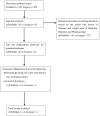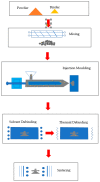Prospect of Metal Ceramic (Titanium-Wollastonite) Composite as Permanent Bone Implants: A Narrative Review
- PMID: 33430455
- PMCID: PMC7826931
- DOI: 10.3390/ma14020277
Prospect of Metal Ceramic (Titanium-Wollastonite) Composite as Permanent Bone Implants: A Narrative Review
Abstract
This literature review discusses the influence of titanium ceramic composites as a biomaterial towards the fabrication of implants for orthopedic applications. The concept of applying metal-ceramic composites enable many novel combinations in the design and fabrication of complex materials which enhances functionality to improve cell and tissue matrix interactions particularly in the formation of bone. Specific focus is placed on its plethora of materials selected from the metals and ceramic group and identifying the optimal combination that matches them. The prospect of wollastonite as the ceramic counterpart is also highlighted. In this review, we have highlighted the different fabrication methods for such metal-ceramic materials as well as the role that these hybrids play in an in vitro and in vivo environment. Its economic potential as a bone implant material is also discussed.
Keywords: bioceramic; mesenchymal stem cells bone implants; titanium; wollastonite.
Conflict of interest statement
The authors declare no conflict of interest.
Figures





Similar articles
-
Incorporation of wollastonite bioactive ceramic with titanium for medical applications: An overview.Mater Sci Eng C Mater Biol Appl. 2019 Apr;97:884-895. doi: 10.1016/j.msec.2018.12.056. Epub 2018 Dec 19. Mater Sci Eng C Mater Biol Appl. 2019. PMID: 30678979 Review.
-
Bone-bonding behavior of plasma-sprayed coatings of BioglassR, AW-glass ceramic, and tricalcium phosphate on titanium alloy.J Biomed Mater Res. 1996 Feb;30(2):261-9. doi: 10.1002/(SICI)1097-4636(199602)30:2<261::AID-JBM17>3.0.CO;2-P. J Biomed Mater Res. 1996. PMID: 9019492
-
CaSiO3-HAp Metal-Reinforced Biocomposite Ceramics for Bone Tissue Engineering.J Funct Biomater. 2023 May 8;14(5):259. doi: 10.3390/jfb14050259. J Funct Biomater. 2023. PMID: 37233369 Free PMC article.
-
Influence of straight versus angulated screw channel titanium bases on failure loads of two-piece ceramic and titanium implants restored with screw-retained monolithic crowns: An in-vitro study.Clin Oral Implants Res. 2023 Nov;34(11):1217-1229. doi: 10.1111/clr.14157. Epub 2023 Aug 11. Clin Oral Implants Res. 2023. PMID: 37565379
-
Long-Term Success of All-Ceramic Dental Implants Compared with Titanium Implants.J Long Term Eff Med Implants. 2021;31(1):73-89. doi: 10.1615/JLongTermEffMedImplants.2021037400. J Long Term Eff Med Implants. 2021. PMID: 33822537 Review.
Cited by
-
Interaction of Ceramic Implant Materials with Immune System.Int J Mol Sci. 2023 Feb 20;24(4):4200. doi: 10.3390/ijms24044200. Int J Mol Sci. 2023. PMID: 36835610 Free PMC article. Review.
-
Prosthetic Metals: Release, Metabolism and Toxicity.Int J Nanomedicine. 2024 Jun 5;19:5245-5267. doi: 10.2147/IJN.S459255. eCollection 2024. Int J Nanomedicine. 2024. PMID: 38855732 Free PMC article. Review.
-
Beyond Tissue replacement: The Emerging role of smart implants in healthcare.Mater Today Bio. 2023 Aug 29;22:100784. doi: 10.1016/j.mtbio.2023.100784. eCollection 2023 Oct. Mater Today Bio. 2023. PMID: 37731959 Free PMC article. Review.
References
-
- Ng M.H., Duski S., Tan K.K., Yusof M.R., Low K.C., Mohamed Rose I., Mohamed Z., Bin Saim A., Haji Idrus R.B. Repair of segmental load-bearing bone defect by autologous mesenchymal stem cells and plasma-derived fibrin impregnated ceramic block results in early recovery of limb function. Biomed. Res. Int. 2014;2014 doi: 10.1155/2014/345910. - DOI - PMC - PubMed
-
- Tan K.K., Tan G.H., Shamsul B.S., Chua K.H., Ng M.H., Ruszymah B.H., Aminuddin B.S., Loqman M.Y. Bone graft substitute using hydroxyapatite scaffold seeded with tissue engineered autologous osteoprogenitor cells in spinal fusion: Early result in a sheep model. Med. J. Malays. 2005;60:53–58. - PubMed
-
- Ng A.M.H., Tan K.K., Phang M.Y., Aziyati O., Tan G.H., Isa M.R., Aminuddin B.S., Naseem M., Fauziah O., Ruszymah B.H.I. Differential osteogenic activity of osteoprogenitor cells on HA and TCP/HA scaffold of tissue engineered bone. J. Biomed. Mater. Res. Part A. 2008;85:301–312. doi: 10.1002/jbm.a.31324. - DOI - PubMed
Publication types
Grants and funding
LinkOut - more resources
Full Text Sources
Other Literature Sources

